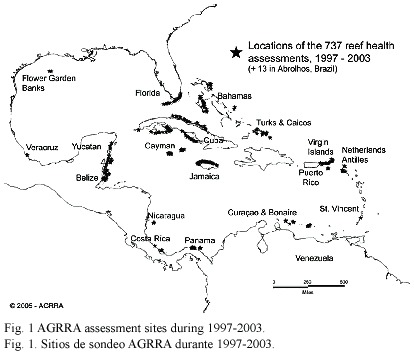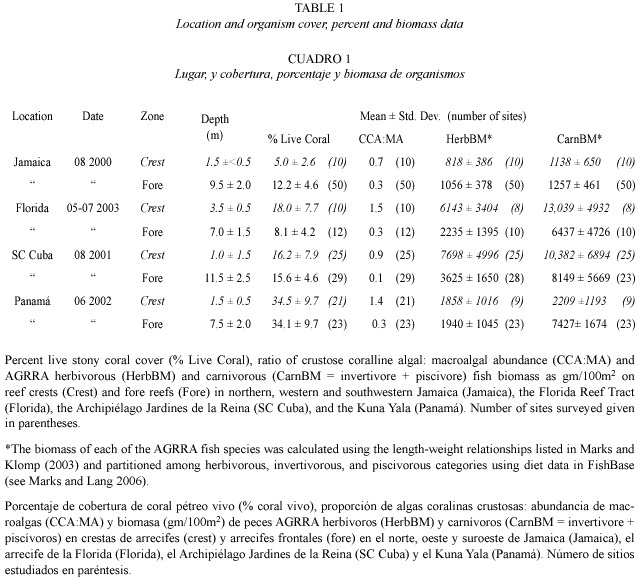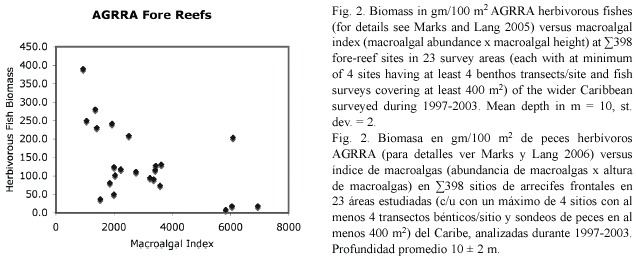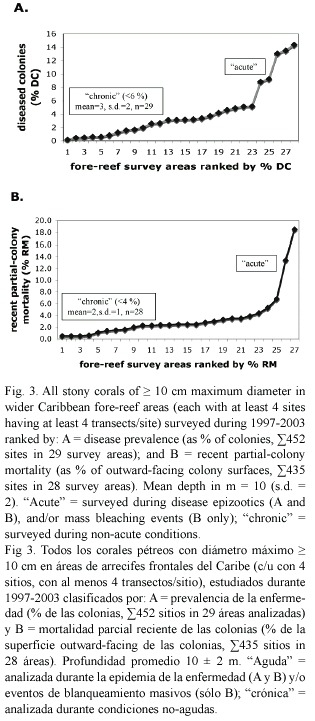Services on Demand
Journal
Article
Indicators
-
 Cited by SciELO
Cited by SciELO -
 Access statistics
Access statistics
Related links
-
 Similars in
SciELO
Similars in
SciELO  uBio
uBio
Share
Revista de Biología Tropical
On-line version ISSN 0034-7744Print version ISSN 0034-7744
Rev. biol. trop vol.54 suppl.3 San José Dec. 2006
A vision for regular, rapid assessments of the tropical northwestern Atlantics coral reefs
Judith C. Lang1,2 & Robert N. Ginsburg2
1 P.O. Box 539, Ophelia, Virginia 22530, USA. Fax 01 804 453-6605; info@agrra.org
2 Marine Geology and Geophysics, Rosenstiel School of Marine and Atmospheric Science, University of Miami, 4600 Rickenbacker Causeway, Miami, Florida 33149, USA. Fax 01 305 421-4094; rginsburg@rsmas.miami.edu
Received 06-VI-2006. Corrected 02-X-2006. Accepted 13-X-2006.
Abstract: The Atlantic and Gulf Rapid Reef Assessment (AGRRA) Program, consisting of non-fixed, transect- based visual surveys, provides "snapshot" characterizations of a number of structurally or functionally important benthic and fish indicators on tropical northwestern Atlantic (TNWA) coral reefs and Brazil. To ameliorate the confounding factors inherent in multiyear temporal variation, a region-wide collaborative program for conducting rapid reef assessments at regular (five-year) intervals in sites that are representative of each sub-region of the TNWA is proposed. Member institutions of the Association of Marine Laboratories of the Caribbean (AMLC) and individual colleagues are invited to join in developing the vision. Rev. Biol. Trop. 54 (Suppl. 3): 23-29. Epub 2007 Jan. 15.
Key words: coral reefs, rapid assessment, AGRRA, AMLC, long-term monitoring, monitoring, coral reef integrity.
Coral reefs in the wider Caribbean have recently experienced notable losses from diseases, bleaching, overfishing, algal encroachment and poor water quality. Conspicuous deterioration by the early 1990s near marine laboratories and other institutional members of the AMLC (Ginsburg and Glynn 1994) helped spur the development of intensive monitoring programs, particularly in Florida, the U.S Virgin Islands and Colombia. Not known at the time was the extent to which these well-studied reefs were representative of the region as a whole, or how much local impacts were affecting the decline of reefs in densely populated areas like the Florida Keys. The AGRRA Program (http://www.agrra.org/) was developed to address these broad-scale concerns with a standardized protocol that could be applied relatively inexpensively at large numbers of reef sites over wide geographic areas. A long-term goal of the program is to be able to provide standardized, quantitative data suitable for evaluation of reef condition across the entire TNWA (after Ginsburg and Lang 2003).
Initially focused on the health of stony corals, that can grow large enough to contribute to reef formation, and using approaches adapted from the pioneering studies of Dustan (1994) and Diaz et al. (1995), the AGRRA Protocols quickly evolved to include algal groups, certain fishes, particularly herbivores and large predators, and the echinoid Diadema antillarum. Thus its primary indicators are based on key contributors to the structure (stony corals) and function (algae, fishes, Diadema) of Caribbean-area reef ecosystems (Kramer 2003) with piscivorous fishes also serving as a fisheries-independent estimate of fishing intensity.
The AGRRA Programs accomplishments to date include: (1) working relationships with reef scientists or managers in most western Atlantic countries having significant reefs; (2) capacity building during workshops and less formal training sessions; (3) survey expeditions to many of the Caribbean areas sub-regions (Fig. 1); (4) periodic revisions of the protocol as warranted by experience (Version 4 was released online in June, 2005); (5)descriptions, and a summary, of the early (to mid-2000) assessments (Lang 2003); (6) maintaining the only large-scale, directly comparable, biological datasets for TNWA reefs; (7) unrestricted access (the 1997-2003 databases with 64 230 stony corals, 22 693 algal quadrats, and 188 418 fishes and diverse derived summary products were posted online in August, 2005). Meantime many national or regional groups (including government agencies, universities, non-governmental organizations and environmental consultants) have adopted or adapted the AGRRA Protocols for use in other rapid-assessment or non-fixed-monitoring programs.

As exemplified in Table 1, we have learned that parameters such as percent live coral cover, the ratio of crustose coralline algal: macroalgal abundance, and herbivorous or carnivorous fish biomass can vary across spatial scales that vary from the local to sub-regional. Similar to the findings of Williams and Polunin (2001), in the near-absence of Diadema ,we find that herbivorous fish biomass is inversely correlated with macroalgal index (a proxy for macroalgal biomass) on fore reefs in many of the surveyed areas (Fig. 2). We believe we are very close to establishing regional "chronic condition norms" for some ecologically relevant parameters, two of which are illustrated in Figure 3.



The AGRRA data have been used to examine reef fish assembly patterns (Semmens and Auster 2004), evaluate the status of Acropora spp. (Biological Review Team 2005), and construct quantitative interpretive frameworks for some of the ecological indicators used in the Healthy Mesoamerican Reef Ecosystem Initiative (McField and Kramer 2005). As efforts mount to "build resilience" into the planning and management of coral reef resources, and to design integrated networks of marine protected areas (West and Salm 2003), the perceived value of its large datasets will increase.
Mean values for the AGRRA indicators in each area also constitute current baselines against which future changes in local reef condition and finfish resources can be compared. Nonetheless, regional-scale interpretations of these data are inevitably constrained by the confounding of temporal and spatial variation that has occurred throughout the nine years during which the assessments were conducted. For example, in areas originally surveyed in 1998 or 1999, live stony coral cover significantly declined on many reefs that were severely affected by the 1998 ENSO-related mortality event (Belize – Robbart et al. 2004; Mexico – Roy 2004; Bahamas– Lang, pers. obs.), even as conditions were improving in a few sites (Jamaica- Edmunds and Carpenter 2001, Idjadi et al. 2006).
To overcome the inherent constraints of multiyear temporal variation, we envision a region-wide collaborative program in which reef assessments are conducted at regular intervals. Given the rapid pace at which reef ecosystems are currently changing (Precht and Aronson 2006), a sampling interval of five-years, at least for the short-term, was proposed at the AMLCs 32nd scientific meeting in June 2005. The urgency of the need for periodic reassessments of Caribbean-area reefs was subsequently underscored when unusually warm seawater temperatures caused extremely high levels of bleaching and bleaching-related mortality on many reefs in the eastern and northern TNWA. Disease outbreaks, first noticed as stony corals were recovering their coloration in some sites, are still on-going as of May 2006 (B.V.I. – S. Gore pers. comm.; Martinique – J. P. Maréchal and C. Cowan, pers. comm.; Puerto Rico – E. Weil pers. comm.).
It is beyond our scope at present to provide a detailed implementation plan, but we can offer some indications of what will be needed in terms of protocols, candidate sampling sites, and logistics.
Elements of a Plan for Regional Visits to assess the Condition of Representative Reef Communities: From our experience with the AGRRA Program, we believe that the assessments must include key elements of the reef ecosystem–stony corals, fishes and algae. We know that protocols can be designed to allow a team of about five, trained researchers to complete a survey of one site in a single dive. Selecting the candidate survey sites is not simple, given the extent of the region, the variability of reef types, their spatial distribution, relationships to the ocean current systems, and exposure to seas and swells. Information in the AGRRA Database, our understanding of the extent of anthropogenic impacts and fishing pressures (e.g., Burke and Maidens 2004), any existing legal protections, and other local knowledge about habitats and community condition must also be considered.
Earlier efforts in developing a sampling design (Kramer 2003) were focused on the tactics of site-specific activities (e.g., the number of transects, corals or algal quadrats/site), rather than dealing strategically with overall survey designs to reduce variance in population and community parameters. Now that statistical methods (Ault et al. 2002) based on classical sampling techniques (Cochran 1977) are available for coral reefs, we have received funds for an analysis of the existing AGRRA coral dataset at various spatial scales to determine appropriate sample unit sizes, sampling strata boundaries, and survey domain areas. Analyses focused on size classes (approximate life history stages) of several species in each of five, common scleractinian genera (Montastraea, Diploria, Siderastrea, Agaricia, and Porites) would allow us to identify data outliers or errors, completeness over the expected temporal and spatial domains, gaps, and estimation properties (e.g., precision) of primary indicators and derived variables (J. Ault, pers. comm.). New regional classifications, such as the geomorphological maps being produced by the Millennium Coral Reef Mapping Project (http://imars.usf.edu/corals/index.html) and any available habitat maps (e.g., Kendall et al. 2001), would be used to generate GIS products in which sampling domains would be stratified according to principal environmental variables (bathymetry, geomorphology, oceanography, etc.).
Results of these analyses may well warrant modifications to the current versions of the AGGRA benthos sampling protocols. After identification of a preferred sampling design, sampling units would be optimally allocated within strata among locales according to a weighted relationship between stratum area and variance. Specific sampling sites within a stratum for the first regional survey would be randomly selected from the complete list of potential sample units. Use of a discrete uniform probability distribution that assigns equal selection probability to each unit would ensure that the collected data are fully representative of the entire TNWA reefal area. The design would be re-run for every five-year assessment, ideally each time with a refined sampling allocation allowing improved sensitivity (lower coefficient of variation) for detecting change at the scales of interest (P.A. Kramer, pers. comm.).
At least two ways of executing the assessments need to be considered: (1)sub-regional teams of assessors thoroughly trained in the protocols could be responsible for making the surveys in each sub-region; (2) one or more vessels, fully equipped for diving, could be chartered for a series of cruises involving core teams of trained assessors and locally trained participants in each sub-region. (Live-aboard dive boats that can support scientific research are available: we know one that was used most effectively for fish and benthos assessments covering the entire, 350-km long, Florida Reef Tract.)
Geographic separation of our insular and continental nations creates expensive challenges in coordinating international programs. The AMLC is an organization with a record of fostering regional collaboration, and collectively its members represent the entire region. Hence, our gratitude that the AMLC Executive Board agreed to be the first international organization to endorse a resolution supporting "the immediate establishment of a long term program for assessing representative reefs, their related biological communities, and relevant physical environmental parameters periodically into the future." Many details are yet to be decided, and member institutions and individual members of the AMLC network, as well as other colleagues, are invited to join with us to help develop this new phase of regional rapid assessment in the wider Caribbean.
Acknowledgments
JCL thanks the Ocean Research and Education Foundation for financial support to attend the 32nd Scientific Meeting of the AMLC at Curaçao, in June 2005. Ingrid Morgan kindly provided Fig. 2. Steve LaGore, the AMLC Executive Director, is thanked for his encouragement and guidance of our efforts. We appreciate Norman Quinns thoughtful review of the initial manuscript.
Resumen
El Programa de Evaluación Rápida del Atlántico y el Golfo (AGRRA, por sus siglas en inglés) consiste en sondeos visuales no-fijos, basados en transectos, que permiten caracterizaciones puntuales de un número de peces y organismos bénticos que sean estructural o funcionalmente importantes como indicadores en arrecifes del Atlántico tropical noroeste (ATNO) y de Brasil. Para disminuir los factores de confusión inherentes a variaciones temporales multianuales, se propone un programa de colaboración a nivel regional, que sirva para conducir evaluaciones rápidas de los arrecifes en intervalos regulares (cinco años), en los sitios que sean representativos de cada sub-región del ATNO. Se invita a las instituciones miembro de la Asociación de Laboratorios Marinos y del Caribe (ALMC), así cómo a colegas individuales para participar en el desarrollo de esta visión.
Palabras clave: arrecifes de coral, evaluación rápida, AGRRA, AMLC, monitoreo a largo plazo, monitoreo, integridad de los arrecifes de coral.
References
Ault, J. S., S. G. Smith, J. Lao, G. A. Meester, J. A. Bohnsack & S. L. Miller. 2002. Baseline multispecies coral reef fish stock assessment for the Dry Tortugas. NOAA Tech. Memo. NMFS-SEFSC-487. 117 p. [ Links ]
Biological Review Team (convened by NOAA Fisheries Service). 2005. Atlantic Acropora Status Review Document. CD. National Oceanic and Atmospheric Administration, Silver Spring, Maryland, USA. [ Links ]
Burke, L. & J. Maidens. 2004. Reefs at Risk in the Caribbean. World Resources Institute, Washington, D.C. 80 p. [ Links ]
Cochran, W. G. 1977. Sampling Techniques, 3rd edition. John Wiley, New York, New York, USA. 428 p. [ Links ]
Diaz, J. M., J. Garzón-Ferreira & S. Zea. 1995. Los Arrecifes coralinos de la Isla de San Andrés, Colombia: Estado actual y perspectivas para su conservación. Acad. Col. Cienc. Exac., Fís. Natur. Edit. Guadalupe, Colombia. 150 p. [ Links ]
Dustan, P. 1994. Developing methods for assessing coral reef vitality: a tale of two scales, p. 38-44. In R.N. Ginsburg (compiler), Proceedings of the Colloquium on Global Aspects of Coral Reefs: Health, Hazards, and History. Rosenstiel School Mar. Atm. Sci., Univ. Miami, Miami, USA. [ Links ]
Edmunds, P. J. & R. C. Carpenter. 2001. Recovery of Diadema antillarum reduces macrolagal cover and increases abundance of juvenile corals on a Caribbean reef. Proc. Natl. Acad. Sci. USA 98: 5067-5071. [ Links ]
Ginsburg, R. N. & P. D. Glynn. 1994. Summary of the colloquium and forum on global aspects of coral reefs: health, hazards, and history, p. i-viii. In R. N. Ginsburg (compiler), Proceedings of the Colloquium on Global Aspects of Coral Reefs: Health, Hazards, and History. Rosenstiel School Mar. Atm. Sci., Univ. Miami, Miami. [ Links ]
Ginsburg, R. N. & J. C. Lang. 2003. Forward, p. vii-xiii. In J. C. Lang (ed.). Status of Coral Reefs in the Western Atlantic: Results of Initial Surveys, Atlantic and Gulf Rapid Reef Assessment (AGRRA) Program. Atoll Res. Bull. 496. [ Links ]
Idjadi, J. A., S. C. Lee, J. F. Bruno, W. F Precht, L. Allen-Requa & P. J. Edmunds. 2006. Rapid phase-shift reversal on a Jamaican coral reef. Coral Reefs 25: 209-211. [ Links ]
Kendall, M. S., M. E. Monaco, K. R. Buja, J. D. Christensen, C. R. Kruer, M. Finkbeiner & R. A. Warner. 2001. (Online). Methods Used to Map the Benthic Habitats of Puerto Rico and the U.S. Virgin Islands. URL: http://biogeo.nos.noaa.gov/projects/mapping/caribbean/startup.htm. Also available on U.S. National Oceanic and Atmospheric Administration. National Ocean Service, National Centers for Coastal Ocean Science Biogeography Program. 2001. (CD-ROM). Benthic Habitats of Puerto Rico and the U.S. Virgin Islands. National Oceanic and Atmospheric Administration, Silver Spring, Maryland. [ Links ]
Kramer, P. A. 2003. Synthesis of coral reef health indicators for the western Atlantic: results of the AGRRA program (1997-2000), p. 1-55. In J. C. Lang (ed.). Status of Coral Reefs in the Western Atlantic: Results of Initial Surveys, Atlantic and Gulf Rapid Reef Assessment (AGRRA) Program. Atoll Res. Bull. 496. [ Links ]
Lang, J.C. 2003. (ed.). Status of Coral Reefs in the Western Atlantic: Results of Initial Surveys, Atlantic and Gulf Rapid Reef Assessment (AGRRA) Program. Atoll Res. Bull. 496. 630 p. [ Links ]
Macfield, M. D. & P. R. Kramer. 2005. The Healthy Mesoamerican Reef Ecosystem Initiative: a conceptual framework for evaluatin reef ecosystem health. Proc. 10th Int. Coral Reef Symp. Okinawa: 1118-1123. [ Links ]
Marks, K. W. & J. C. Lang. 2006. "AGRRA Summary Products, version (10/2006)." [ Links ]
Marks, K. W. & K. D. Klomp. 2003. Appendix Two Fish biomass conversion equations. p. 625-628. In J.C. Lang (ed.), Status of Coral Reefs in the Western Atlantic: Results of initial Surveys, Atlantic and Gulf Rapid Reef Assessment (AGRRA) Program. Atoll Res. Bull. 496. [ Links ]
Precht, W. F & R. B. Aronson. 2006. Death and resurrection of Caribbean coral reefs: A paleoecological perspective, p. 40-77. In I. Côté & J. Reynolds (eds.). Coral Reef Conservation. Zool. Soc. London, Cambridge University Press, Cambridge. [ Links ]
Robbart, M. L., P. Peckol, S. P. Scordilis, H. A. Curran & J. Brown-Saracino. 2004. Population recovery and differential heat shock protein expression for the corals Agaricia agaricites and A. tenuifolia in Belize. Mar. Ecol. Prog. Ser. 283: 151-160. [ Links ]
Roy, R. E. 2004. Akumals reefs: Stony coral communities along the developing Mexican Caribbean coastline. Rev. Biol. Trop. 52: 869-881. [ Links ]
Semmens, B. X. & P. J. Auster. 2004. Analysis of Caribbean-wide reef fish data using multilple community assembly rule models. 10th Int. Coral Reef Symp., Okinawa. Abstract. p. 199. [ Links ]
West, J. M. & R. V. Salm. 2003. Resistance and resilience to coral bleaching: implications for coral reef conservation and management. Conserv. Biol. 17: 956-967. [ Links ]
Williams, I. D. & N. V. C. Polunin. 2001. Large-scale associations between macroalgal cover and grazer biomass on mid-depth reefs in the Caribbean. Coral Reefs 19: 358-366. [ Links ]














